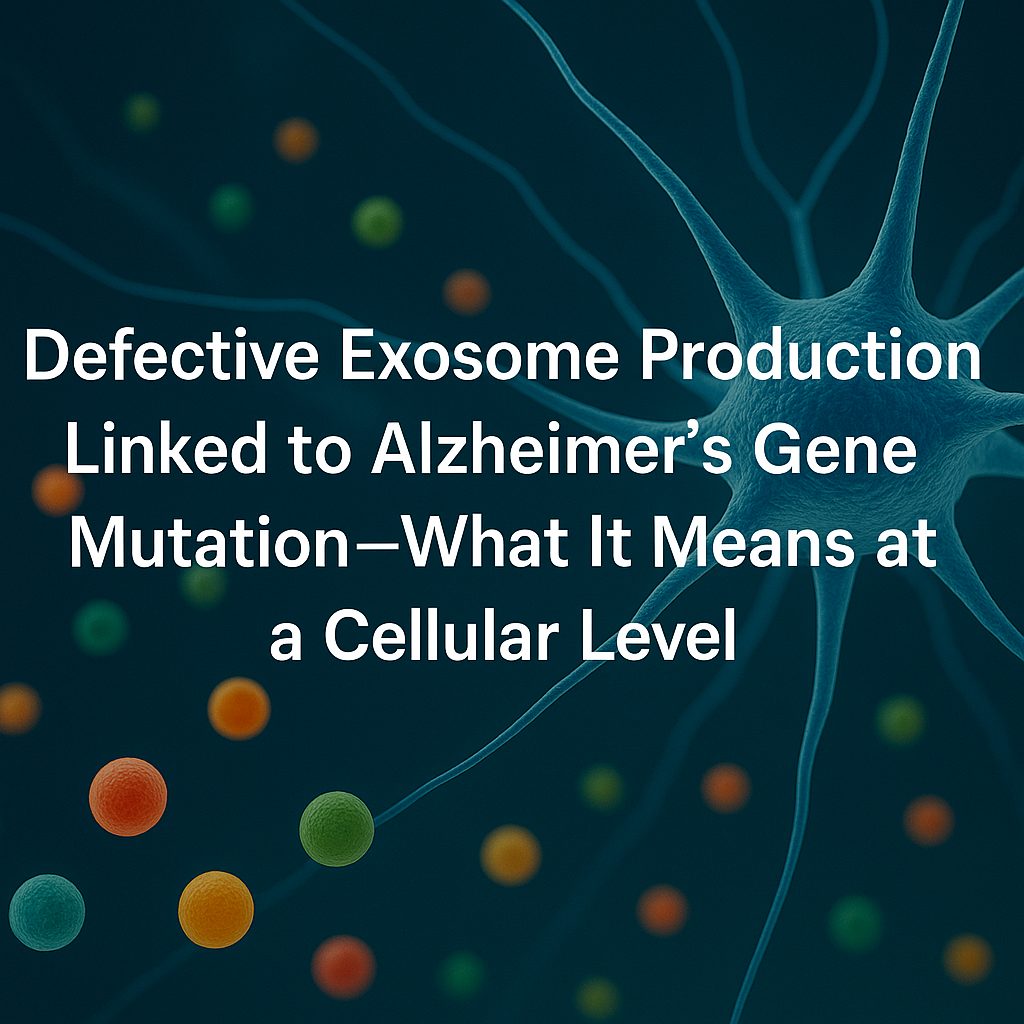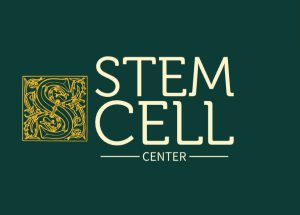Defective Exosome Production Linked to Alzheimer’s Gene Mutation — What It Means at a Cellular Level

Recent research from Aarhus University has revealed that a certain gene mutation connected with Alzheimer’s disease disrupts the production and function of exosomes in the brain—tiny cellular packages that help cells communicate with each other. This discovery sheds new light on how Alzheimer’s might develop and opens up possible new therapeutic paths or a Alzheimer’s cure. Below, we’ll explain what was found, what exosomes are, how the SORLA mutation plays a role, and what this could mean for future Alzheimer’s treatments.
What Are Exosomes, and Why Do They Matter?
-
Exosomes are very small vesicles (tiny bubbles) released by cells. They carry proteins, RNAs (including microRNAs), lipids, and other molecules. Cells use exosomes to send signals to other cells—think of them like tiny packages delivered between cells.
-
In the brain, exosomes help neurons, microglia (immune cells of the brain), and other cell types communicate. They help with maintenance, supporting cell growth, repair, and keeping the environment healthy.
-
If exosome production is reduced, or their contents are degraded or altered, the ability of cells to support each other properly may suffer. Over time, this could contribute to degeneration, as in Alzheimer’s disease.
The Gene Mutation: SORL1 / SORLA
-
The SORL1 gene encodes a protein known as SORLA (Sortilin-related receptor with A-type repeats). It’s involved in trafficking and processing proteins inside cells, especially in neurons and microglia.
-
Some mutations in SORL1 are linked to familial Alzheimer’s disease (i.e. inherited forms of Alzheimer’s). One particular mutation studied is called SORLA^N1358S, which occurs in a part of the protein that binds ligands (other molecules) important for its normal function.
Key Findings of the Study
Researchers compared human induced pluripotent stem cells (iPSCs) engineered with this SORLA^N1358S mutation vs. control cells without the mutation, focusing on neurons and microglia. Their findings include:
| Finding | What it means |
|---|---|
| Cells with the mutated SORLA produced ≈ 30% fewer exosomes than normal cells. | Fewer messaging “packages” going out—so less intercellular communication. |
| The exosomes that were produced were up to ~50% less effective at stimulating growth and maturation in neighboring cells. | Even the exosomes that are made are of poorer quality / less functional. |
| The content of exosomes, including specific microRNAs, was altered in the mutant case. Some microRNAs are known to regulate neuronal development & maturation. | This means the “message” carried by exosomes is different / defective. |
These defects are not just about quantity (number of exosomes) but also quality (what cargo they carry and how well they act to support brain-cell health). The researchers used techniques like “omics” (examining many proteins / RNAs at once) and cell‐based assays to measure impact.
Why This Matters for Alzheimer’s
Alzheimer’s disease involves accumulation of misfolded proteins (like amyloid-beta and tau), neuroinflammation (immune response in brain), and loss of neurons / synapses. Efficient intercellular communication is essential to:
-
Clear misfolded proteins.
-
Maintain cell health.
-
Support repair.
-
Modulate immune responses.
If exosomes are fewer or malfunctioning, these protective or maintenance tasks may be compromised. Mutation in SORL1 → defective SORLA → fewer / poorer exosomes → less support for neurons and microglia → accelerated path toward Alzheimer’s disease pathology.
Possible Therapeutic Implications
The study suggests several possible strategies:
-
Restoring or enhancing SORLA function. If we can correct or compensate for the SORLA mutation (by gene therapy, small molecules, etc.), exosome production and quality might improve.
-
Boosting exosome production via other pathways. Even without directly fixing SORLA, there may be other receptors or cellular machinery that can be targeted to raise exosome output or improve cargo quality.
-
Using exosomes as therapeutic delivery systems. Possibly engineer exosomes to carry beneficial molecules (neurotrophic factors, corrected microRNAs) to affected brain regions.
-
Diagnostic use. Measuring exosome number or their cargo quality in easily accessible body fluids (like cerebrospinal fluid, or blood) might serve as biomarkers of Alzheimer’s risk or progression.
How the Study Was Done (The Methods Behind the Findings)
To appreciate the results, here’s a more detailed look at the scientific methods:
-
iPSC-derived human neurons and microglia. These are stem-cell-based models: adult cells reprogrammed into pluripotent stem cells, then differentiated into neurons or microglia. This allows studying human brain-cell behavior in a dish.
-
Comparative approach. They had cells with the SORLA^N1358S mutation and matched control cells (without mutation) to observe differences attributable to the mutation.
-
“Omics” analyses. This includes proteomics (looking at many proteins) and RNA profiling (mRNAs, microRNAs) to see what exosomes are carrying, and how that differs with mutation.
-
Functional assays. Tests to see how exosomes affect neighboring cells: Do they stimulate growth? Do they help with maturation / health? These tests showed mutant exosomes were significantly less active.
Limitations & What Still Needs Work
While this research is promising, there are some caveats and open questions:
-
Model limitations. The experiments were done in vitro (in lab cell cultures). How exactly this translates to human brains in vivo (in living persons) needs further study.
-
Other genes & mutations. SORL1 is only one of several genes implicated in Alzheimer’s. How SORLA interacts with other Alzheimer’s risk factors (genetic and environmental) remains to be clarified.
-
Therapeutic delivery challenges. If we aim to boost exosome production or deliver “good” exosomes therapeutically, crossing the blood-brain barrier and ensuring safety are still significant hurdles.
-
Temporal dynamics. At what stage of Alzheimer’s do these exosome defects become significant? Are they early indicators or downstream consequences? Knowing that is important for diagnostics and intervention.
Summary & Big Take-Home
-
A mutation in SORL1 (encoding the receptor protein SORLA) reduces both the number and the effectiveness of exosomes produced by neurons and microglia.
-
Both quantity and quality of exosomes are impaired: fewer exosomes are released, and those released are less capable of supporting neighboring cell development or maturation.
-
Altered cargo, including changes in microRNAs, appears to underlie the reduced neurotrophic (supporting neuron growth) properties.
-
This finding strengthens the idea that Alzheimer’s disease involves not just pathological accumulation (like of amyloid) but also failures in the cell-cell communication and support network of the brain.
-
Possible future therapies could focus on restoring exosome functionality, either by targeting SORLA directly or via auxiliary pathways, and possibly using exosomes themselves as delivery vehicles or biomarkers.
At Stem Cells Center Malaysia, we are dedicated to translating complex neuroscience findings into practical knowledge for patients, families, and healthcare professionals. Our team continuously reviews the latest global research to provide clear explanations and to explore how breakthroughs in exosome biology and stem cell therapy can one day contribute to better prevention, diagnosis, and treatment of neurodegenerative diseases like Alzheimer’s. By bridging advanced science with real-world applications, we aim to empower you to make informed decisions about your health journey.
Since Alzheimer’s is a progressive disease, we strongly encourage patients and families not to delay seeking help. We recommend coming in for a comprehensive medical check-up at our center, where our specialists can assess your current condition and determine whether exosome or stem cell therapy is suitable for you. This ensures a safe, personalized, and effective treatment plan tailored to your unique needs.
Source: This article is based on “Defective Exosome Production Linked to Alzheimer’s Gene Mutation” as reported by Neuroscience News, summarizing research from Aarhus University. Neuroscience News





